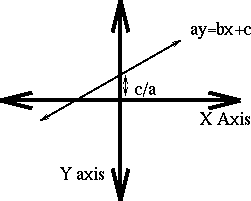 12.6. 2-D Geometry
12.6. 2-D Geometry  12.6. 2-D Geometry
12.6. 2-D Geometry Lines
(1) ay=bx+c is equation of any straight line.
b/a is tangent of angle that line makes with
positive x-axis.

Fig. 12.5 : Geometry illustration.

if b=0, tangent is 0 and hence y = const.
if a=0, tangent is infinite and line is x = const.
and c/a (if finite) is the intercept of line on y-axis.
if infinite then line // to y axis.


p1 =(x1 ,y1 )
p2 =(x2 ,y2 )


Therefore p=(x,y) can be given as
(1-)p1 +
p2 for some real
.
=((1-)x1 +
x2 , (1-
)y1 +
y2 )
where if 0<=<=1 then p lies between p1 and p2
= ( distance of p -> p1 ) / ( distance of p2 -> p1)


Example:
Calculate point of intersection p = (x,y) of two lines joining:
p1 =(x1 ,y1 ) -> p2 =(x2 ,y2 )
and p3 =(x3 ,y3 ) -> p4 =(x4 ,y4 )
General point p =
(1) (1-)p1 +
p2
(2) (1-)p3 +
p4
since P is on both lines.
(1-
)p1 +
p2 = (1-
)p3 +
p4 = p
=> (1-)x1 +
x2 = (1-
)x3 +
x4
and (1-)y1 +
y2 = (1-
)y3 +
y4
=>(x2 - x1 ) +
(x3 - x4 ) = x3 - x1
and(y2 - y1 ) +
(y3 - y4 ) = y3 - y1
2-equations -2 unknowns ---> soluble.
Set= (x2 - x1 )(y3 - y4 ) - (x3 - x4 )(y2 - y1 )
=>= { (x3 - x1 )(y3 - y4 )- (x3 - x4 )(y3 - y1 ) } /



subprogram intercept (x1,y1,x2,y2,x3,y3,x4,y4,X,Y:real)
local real psi,phi;
psi  (x1-x2)*(y4-y3)-(y1-y2)*(x4-x3);
(x1-x2)*(y4-y3)-(y1-y2)*(x4-x3);
if (abs(psi)<0.00001) then {lines are //}
else
begin
phi  ((X3-X1)*(Y3-Y4)-(X3-X4)*(Y3-Y1))/psi;
((X3-X1)*(Y3-Y4)-(X3-X4)*(Y3-Y1))/psi;
X  (1-phi)*X1+phi*X2;
(1-phi)*X1+phi*X2;
Y  (1-phi)*Y1+phi*Y2;
(1-phi)*Y1+phi*Y2;
endif;
return;
end_subprogram.













